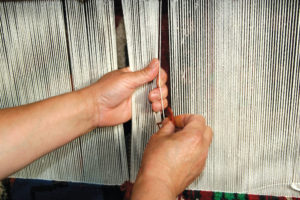Many clients call us or bring in rugs, worried about the buckling in their rugs. They want to know why it has happened, and what can be done to fix it. Today we’re going to discuss why a rug buckles, how you can prevent it, and how a professional rug repairer can fix buckling issues.
1: How Your Rug is Woven
Hand woven rugs are rarely, perfectly symmetrical. There will always be a little variance in the width and length of the rug, as well as some fluctuation in the weaving tension throughout the rug. Buckling from these issues are generally seen as unique characteristics of a rug’s personality and are most often seen in tribal or nomadic woven rugs. They were like laugh lines on a face, only there is no “rug botox” to fix these lines and wrinkles.
Some manufacturers will apply a “sizing” to the rug that is similar to starch, to try to make the rug stiffer and even out weaving variations. However sizing washes out and can be difficult to reapply.
A rug can be stretched to fix weaving variations, but this is a strenuous, expensive process that can damage your rug. It is best to embrace the quirks of these rugs and work with them.
2: Rug Backing
With embroidery, needlepoint, and hooked rugs, buckling can be due to the construction of the rug, especially if it has a heavy material backing. This type of rug construction is elegant but can also have symmetry problems. The two handcrafted pieces – the needlework and the backing – are loosely stitched together, which can cause buckling and waves. This is especially the case along the seams.
Seams can also split under foot traffic, with age, or with cleaning – especially if the individual pieces are made of different fibres. These react differently during the cleaning process. Some fibres will swell, while others condense, meaning the variance can cause the seams to split.
3: Latex Backing on Rugs
Tufted rugs often feature a latex backing that holds the rug together. Over time, latex deteriorates and crumbles away, meaning you need to cover the damage with material. These rugs are better suited to soft floors than hard floors, as carpeted floors are less damaging on the latex. Woven rugs have some give and flex to them, making it safe to use them on any kind of flooring. Tufted rugs are not nearly as forgiving.
4: Heavy Furniture
Placing heavy furniture on top of a rug, especially if the rug is on a carpeted floor, can stretch the fibres of any rug. In the worst case scenario, it can cause tears and holes in woven rugs. It can also cause waves through the rug that you can’t get out. Once a rug has been stretched by heavy furniture, it is very difficult to return it to the original shape.
In the case of latex rugs, this tension and stretching can permanently damage the latex backing. Woven rugs can sometimes have a better chance of reshaping after they have been washed.
To prevent a rug buckling due to foot traffic and furniture, a stabilising rug pad can help. But it is best to ensure rugs are not set under heavy furniture or that they are rotated as needed.
5: Rug Edge Finishes
Sometimes in rug weaving, the ends or sides of the rug are finished too tightly or overdone. This creates a curl in the rug. The curling can be immediate or it may only be evident after the rug gets wet or damp. How badly the rug will buckle depends on how the fibres react to water. Some rug fibres get tighter when wet and loosen when dry.
However, not all rugs function this way. Navajo and American Indian rugs have outside wrapping threads that are not always pre-washed before the final weaving. These strands can shrink during cleaning, giving the illusion that the rug has shrunk.
6: Floods and Water
If a rug is exposed to water for a long time, due to flooding or in-home rug cleaning, it can buckle. This buckling is caused by the cotton wefts absorbing water. In some cases, this buckling can be corrected and decontaminated – but not always.
Further, heavy water extraction equipment can sometimes cause buckling on looser woven rugs. This may or may not be correctable. If your rug has suffered from water exposure, it is better to bring it to a professional rug laundry. Professional cleaners have appropriate equipment to remove water which lowers the risk of buckling.
7: Rugs on Soft Surfaces
Some rug owners like to display their rugs on soft, carpeted surfaces. While this can look fantastic aesthetically, it can be a cause of buckling. Rugs are meant to rest on hard surfaces. When a rug doesn’t have a solid foundation to rest on, this buckling can be magnified. If possible, it is best to place your rug on a hard surface.
Waves and buckles in a rug are not only signs of a rug problem, they are also a safety hazard. If you are concerned about your rug buckling or you have concerns following a flood, contact the team at Wood’s Rug Laundry, today, for help!
